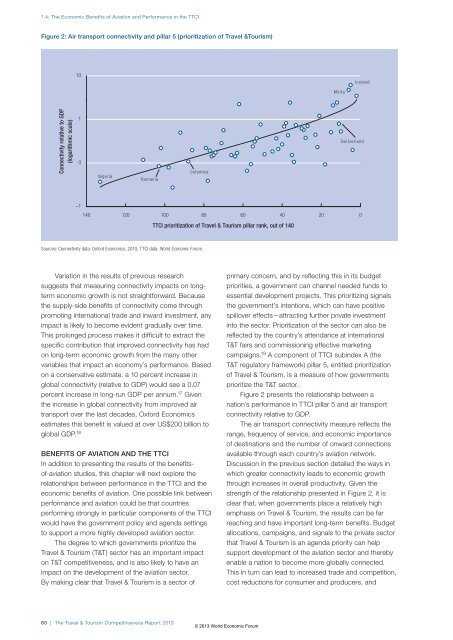The Travel & Tourism Competitiveness Report 2013
The Travel & Tourism Competitiveness Report 2013
The Travel & Tourism Competitiveness Report 2013
Create successful ePaper yourself
Turn your PDF publications into a flip-book with our unique Google optimized e-Paper software.
1.4: <strong>The</strong> Economic Benefits of Aviation and Performance in the TTCI<br />
Figure 2: Air transport connectivity and pillar 5 (prioritization of <strong>Travel</strong> &<strong>Tourism</strong>)<br />
Connectivity relative to GDP<br />
(logarithmic scale)<br />
10<br />
1<br />
0<br />
Nigeria<br />
Romania<br />
–1<br />
140 120 100 80 60 40 20 0<br />
Variation in the results of previous research<br />
suggests that measuring connectivity impacts on longterm<br />
economic growth is not straightforward. Because<br />
the supply-side benefits of connectivity come through<br />
promoting international trade and inward investment, any<br />
impact is likely to become evident gradually over time.<br />
This prolonged process makes it difficult to extract the<br />
specific contribution that improved connectivity has had<br />
on long-term economic growth from the many other<br />
variables that impact an economy’s performance. Based<br />
on a conservative estimate, a 10 percent increase in<br />
global connectivity (relative to GDP) would see a 0.07<br />
percent increase in long-run GDP per annum. 17 Given<br />
the increase in global connectivity from improved air<br />
transport over the last decades, Oxford Economics<br />
estimates this benefit is valued at over US$200 billion to<br />
global GDP. 18<br />
BENEFITS OF AVIATION AND THE TTCI<br />
In addition to presenting the results of the benefitsof-aviation<br />
studies, this chapter will next explore the<br />
relationships between performance in the TTCI and the<br />
economic benefits of aviation. One possible link between<br />
performance and aviation could be that countries<br />
performing strongly in particular components of the TTCI<br />
would have the government policy and agenda settings<br />
to support a more highly developed aviation sector.<br />
<strong>The</strong> degree to which governments prioritize the<br />
<strong>Travel</strong> & <strong>Tourism</strong> (T&T) sector has an important impact<br />
on T&T competitiveness, and is also likely to have an<br />
impact on the development of the aviation sector.<br />
By making clear that <strong>Travel</strong> & <strong>Tourism</strong> is a sector of<br />
60 | <strong>The</strong> <strong>Travel</strong> & <strong>Tourism</strong> <strong>Competitiveness</strong> <strong>Report</strong> <strong>2013</strong><br />
Colombia<br />
Sources: Connectivity data: Oxford Economics, 2010; TTCI data: World Economic Forum.<br />
TTCI prioritization of <strong>Travel</strong> & <strong>Tourism</strong> pillar rank, out of 140<br />
Malta<br />
Iceland<br />
Switzerland<br />
primary concern, and by reflecting this in its budget<br />
priorities, a government can channel needed funds to<br />
essential development projects. This prioritizing signals<br />
the government’s intentions, which can have positive<br />
spillover effects—attracting further private investment<br />
into the sector. Prioritization of the sector can also be<br />
reflected by the country’s attendance at international<br />
T&T fairs and commissioning effective marketing<br />
campaigns. 19 A component of TTCI subindex A (the<br />
T&T regulatory framework) pillar 5, entitled prioritization<br />
of <strong>Travel</strong> & <strong>Tourism</strong>, is a measure of how governments<br />
prioritize the T&T sector.<br />
Figure 2 presents the relationship between a<br />
nation’s performance in TTCI pillar 5 and air transport<br />
connectivity relative to GDP.<br />
<strong>The</strong> air transport connectivity measure reflects the<br />
range, frequency of service, and economic importance<br />
of destinations and the number of onward connections<br />
available through each country’s aviation network.<br />
Discussion in the previous section detailed the ways in<br />
which greater connectivity leads to economic growth<br />
through increases in overall productivity. Given the<br />
strength of the relationship presented in Figure 2, it is<br />
clear that, when governments place a relatively high<br />
emphasis on <strong>Travel</strong> & <strong>Tourism</strong>, the results can be far<br />
reaching and have important long-term benefits. Budget<br />
allocations, campaigns, and signals to the private sector<br />
that <strong>Travel</strong> & <strong>Tourism</strong> is an agenda priority can help<br />
support development of the aviation sector and thereby<br />
enable a nation to become more globally connected.<br />
This in turn can lead to increased trade and competition,<br />
cost reductions for consumer and producers, and<br />
© <strong>2013</strong> World Economic Forum

















